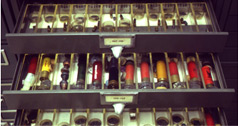Home | Glossary | Resources | Help | Contact Us | Course Map
Archival Notice
This is an archive page that is no longer being updated. It may contain outdated information and links may no longer function as originally intended.
Manufacturer Determination
The objective in observing and recording all of the physical features of fired bullets is to compare them side-by-side and base-to-base against known standards of as many examples of ammunition as possible. Many forensic firearms laboratories maintain a collection of known standards, referred to as the standard ammunition file (SAF). The goal of comparison is to determine the manufacturer or marketer of the evidence or questioned bullet.
Standard Ammunition File Sources
The more comprehensive the standard ammunition file (SAF), the more effective it is. Larger laboratories may budget tens of thousands of dollars annually for their SAF. In other laboratories, the SAF grows through the long-term cooperative effort and input from all examiners.
Materials for the SAF may be obtained from
- individual boxes of ammunition purchased for use in casework,
- seized ammunition in original boxes,
- evidence ammunition being disposed of by evidence custodians of the courts,
- training and operational ammunition obtained from enforcement agencies.
Cataloging
The optimum physical format for an standard ammunition file (SAF) is to acquire two examples of each cartridge. One is left intact and the second is disassembled into its components: cartridge case with primer, bullet, and powder stored in a clear container, envelope, or vial. These items are placed in another numbered plastic container suitable for easy viewing and reference. The SAF can then be physically arranged in numbered containers by caliber, bullet weight, bullet construction, manufacturer, or other criteria as designated by the laboratory. Map-type storage cabinets are ideal for storing the SAF.
Searchability
As an SAF grows, consistency of entry data and its impact of searchability must be addressed. Traditionally, information was entered into the SAF by using index cards arranged in a manner corresponding to the physical file. This search system, while adequate, cannot easily track the growing number of variables in the construction of bullets.
More laboratories are developing computer-driven search programs for the SAF. Accurate encoding of the physical features of bullets is critical to the establishment of an effective computer-based SAF. In some laboratories, a single experienced examiner is tasked with data entry to ensure continuity and consistency.
Identification Resources
To supplement information in an SAF, the following are key resources:
- Line drawings and dimensional data of industry ammunition specifications available through Sporting Arms and Ammunition Manufacturers Institute, Incorporated, (SAAMI) http://www.saami.org/
- Manufacturers brochures, catalogs, and websites
Inconclusive Results
If a careful search of the SAF as well as additional reference resources proves unsuccessful in determining manufacturer/marketer, it is possible to determine the caliber grouping of the bullet. Identifying groupings of bullets of similar diameter/caliber can be useful. Some of the classes most commonly recognized by firearm examiners are .22 caliber/5.56mm class, .38 caliber/9mm class, the .40 caliber/10mm class, and the .30 caliber/7.62mm class.
Additional Online Courses
- What Every First Responding Officer Should Know About DNA Evidence
- Collecting DNA Evidence at Property Crime Scenes
- DNA – A Prosecutor’s Practice Notebook
- Crime Scene and DNA Basics
- Laboratory Safety Programs
- DNA Amplification
- Population Genetics and Statistics
- Non-STR DNA Markers: SNPs, Y-STRs, LCN and mtDNA
- Firearms Examiner Training
- Forensic DNA Education for Law Enforcement Decisionmakers
- What Every Investigator and Evidence Technician Should Know About DNA Evidence
- Principles of Forensic DNA for Officers of the Court
- Law 101: Legal Guide for the Forensic Expert
- Laboratory Orientation and Testing of Body Fluids and Tissues
- DNA Extraction and Quantitation
- STR Data Analysis and Interpretation
- Communication Skills, Report Writing, and Courtroom Testimony
- Español for Law Enforcement
- Amplified DNA Product Separation for Forensic Analysts


